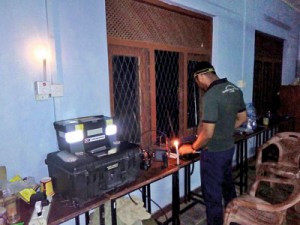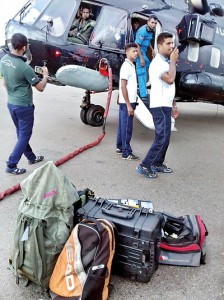News
‘Hams’ step in where all else fails
View(s):Provide communication lifeline for Kalawana patients and support Air Force’s valuable humanitarian operation
By Kumudini Hettiarachchi
Kalawana was helplessly ‘incommunicado’ not because the people wanted to be but because the terrible winds, floods and landslides that ravaged the area had cut off all communications, leaving them isolated and marooned amidst the sorrow and tragedy. There was no electricity and neither mobiles nor land-phones worked.
Suddenly, a few days into the disaster, someone remembered ‘ham’ or amateur radio operators who are part of the Radio Society of Sri Lanka (RSSL).
Please help, came the urgent and frantic call on Sunday, May 28 – Kalawana, one of the worst-hit areas had no communication links with the Coordinating Centre in Ratnapura, 45kms away. The call was from a top official of the Urban Development Authority.

‘Hams’ on alert at the Kalawana Divisional Secretary’s Office, sometimes working in candle-light
The RSSL members were ever-ready to help and major has been this mission they accomplished with aplomb, with ‘equipment’ consisting of a radio each and a wire and car batteries as there was no electricity in Kalawana. These hams set up the most primitive form of communication in this day and age when technology is so advanced but had been incapacitated in the face of nature’s force, needing a ‘back to basics’ approach.
Before all that, how would they get to Kalawana, for the roads were impassable?
“Time was of essence but the weather was changing fast. Even though helicopter flights were dangerous, the Sri Lanka Air Force promptly agreed to airlift our teams,” says an RSSL member, declining to be named because in addition to the six of them who were dropped off, two at Kalawana and four at Ratnapura, many were the others who helped maintain the communication links.
Within an hour, the six were at the Ratmalana Airport, with two Mi-17 military aircraft taking off — with the RSSL members precariously seated amidst boxes of relief items — even though the weather was inclement and the skies were heavy and threatening.
Aghast at the flood-ravaged areas they were flying over, buffeted by strong winds, the two teams reached their destinations, the Divisional Secretary’s Office in Kalawana and the District Secretary’s Office in Ratnapura around 11.30 a.m. “We drew the wire through two barbed wires and set up communications using HF within 20 minutes,” the member says getting down to technicalities.
Three frequency groups have been earmarked for ham or amateur radio licensees. They are HF (High Frequency in which the audio quality is less but it is good for long-distance use); VHF (Very High Frequency, which is crystal clear as long as there are no obstructions in the ‘line of sight’ and uses repeater stations located in Pidurutalagala, Yatiyantota and Deniyaya’s Ensalwatte); and UHF (Ultra High Frequency which is very clear but can only be used for short distances).
While VHF and UHF were not suitable for use in the area, it was HF that came in handy at Kalawana as the area nestles in a valley surrounded by hills and thus the line of sight between Kalawana and Ratnapura had obstructions, the member explains, adding that they used the 40-metre and the 80-metre bands at Kalawana and Ratnapura.
“By 12 noon, the link was established on 7060 kHz LSB, which the amateur radio community was holding clear, informing amateurs to keep the frequency clear, along with the Pidurutalagala Repeater on 145.050,” he says, commending the immense support of fellow amateurs standing-by to give reports and relay messages should the emergency antennae lack clarity.
Roughed out they did, working round-the-clock, munching on flood-relief biscuits and once in a way rice from a packet, while having short spells of shut-eye, stretched out on the floor.
The vigil was with a small generator running at night at the Divisional Secretary’s office at Kalawana, with the Station at Ratnapura having power and transforming into the nerve centre for relief operations in the Sabaragamuwa region.
 Three days of intense work and by Tuesday, May 30, with the telephone network limping back to normal and the main road between Ratnapura, Kalawana and Ayagama cleared, it was ‘Mission Accomplished’ for the weary but satisfied RSSL teams.
Three days of intense work and by Tuesday, May 30, with the telephone network limping back to normal and the main road between Ratnapura, Kalawana and Ayagama cleared, it was ‘Mission Accomplished’ for the weary but satisfied RSSL teams.
The RSSL comprises over 300 licensed hams including engineers, doctors, accountants, teachers, farmers and students and came to fame when they won the ‘Golden Antenna Award’ for their major contribution soon after the tsunami of December 2004 devastated the country.
Ham radio operators use two-way radio stations from their homes, cars and outdoors to make hundreds of friends around town and around the world, communicating with each other using voice, computers and Morse code. While some hams bounce their signals off the upper regions of the atmosphere, so they can talk with hams on the other side of the world, others use satellites. Many, however, are armed with simple hand-held radios that fit in their pockets.
Among the famous hams are King Juan Carlos of Spain, Sonia Gandhi of India, the late Rajiv Gandhi, the late actor Marlon Brando, the late King Birendra of Nepal, the late King Hussein of Jordan and the late astronaut Yuri Gagarin.
Dispelling the notion that they engage in amateur radio as a “hobby”, the RSSL member added: “We use this type of communication to make friends like pen-pals in the olden days and discuss experiences about radio frequencies. Pen-pals wrote letters but hams use radios. We can also make a valuable contribution during emergencies.”
| A Life-saving mission A tiny hand-held radio turned into a life-saver for many a patient at the smaller Kalawana Hospital needing transfer to the bigger and better-equipped Ratnapura Hospital. Unforgettable, for the RSSL members, would be the role they played in saving the life of a young expectant mother among many other nail-biting moments. With the Kalawana doctors requesting an urgent air-lift, for her case was complicated, an Air Force team amidst much bad weather did airlift her along with a trained nurse. The tiny premature baby had to be delivered mid-flight, as the mother went into labour, but did not survive. But the mother’s life was saved. The main communication traffic from Kalawana was urgent medical messages, in addition to the movement of food and other relief. While the hams relayed official messages on food-drops, the patient movement requests were immediately communicated to the Ratnapura District Secretary, handed over for action to the Air Force, which in turn would get the helicopter-flights organized. Thereafter, the hams’ Ratnapura Station would pass on the message to the Kalawana hams to inform the hospital to make the patients ready for air-lifting. Now the hams are back home, having contributed to the relief effort in this latest crisis faced by Sri Lanka. They have some regrets though. “We could have helped many more including hospitals in other affected areas,” the member says, calling on the authorities to “make use” of them when the need arises. | |

